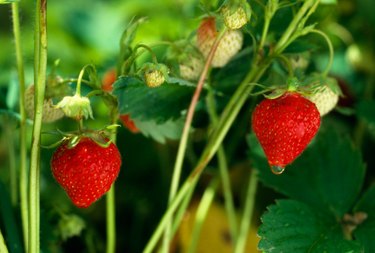Things You'll Need
Shovel
Irrigation tubing
Fertilizer
Polyethylene sheeting
Shade cloth
Fungicide
Pesticide

Strawberries can grow in a variety of climates, from northern mountainous regions to semi-tropical regions such as Columbia, India and Florida. Many varieties are available for different weather conditions. Strawberries prefer cooler temperatures, so timing the cultivation of your plants is crucial in sub-tropical areas of the country. According to the University of Florida, temperatures between 50 and 80 degrees Fahrenheit and 14-hour day lengths are required for successful strawberry cultivation.
Step 1
Till the garden area thoroughly to a depth of 6 inches. Remove weeds, rocks and debris.
Video of the Day
Step 2
Raise the garden bed 3 to 4 inches above ground level. Raised beds create better drainage and allow more oxygen to circulate around strawberry plant roots.
Step 3
Place strawberry plants into the ground. Set plants in double rows approximately 12 inches apart. Tamp soil down around plants.
Step 4
Spread a black polyethylene mulch sheet with slits cut in it to accommodate the plants over the bed area. This helps to prevent weed growth and also keeps the strawberries from direct contact with the ground to preserve fruit.
Step 5
Water plants by allowing a slow soaking with a garden hose until the ground is thoroughly moist.
Step 6
Fertilize plants with 10-5-10 fertilizer with micronutrients such as copper, zinc, iron, manganese and boron. Work 1/4 of the fertilizer into the soil evenly across the surface of the bed. Place the rest of the fertilizer in a band 1 inch deep along the center of the bed.
Tip
The recommended bed size is 7 to 9 inches by 12 inches by 12 to 18 inches.
Water once or twice a week while plants are small, then increase watering to two or three waterings per week. Slow-soak under mulch sheet for 20 minutes. Sub-tropical heat may require additional watering.
Drip irrigation tubing can be planted 2 to 3 inches below the soil line when planting strawberries for easier watering to keep roots moist. Place soil on top of tubing before applying fertilizer.
Warning
Excessive heat in sub-tropical climates will dry out plants and fruit. Water as needed and protect with shade cloth.
Temperatures below 32 degrees Fahrenheit will damage strawberry flowers and fruit. If temperatures drop, cover plants with old sheets or blankets to protect fruit production.
Strawberries are often troubled by fungus in temperatures below 80 degrees. Apply a sulfur fungicide and remove dead or affected leaves to prevent spreading.
Thrips, spider mites and nematodes can infest strawberry plants. Malathion, neem oil or bifenthrin use will help to manage these pests.
Video of the Day